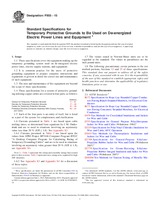We need your consent to use the individual data so that you can see information about your interests, among other things. Click "OK" to give your consent.
ASTM F855-15
Standard Specifications for Temporary Protective Grounds to Be Used on De-energized Electric Power Lines and Equipment
STANDARD published on 1.6.2015
The information about the standard:
Designation standards: ASTM F855-15
Note: WITHDRAWN
Publication date standards: 1.6.2015
SKU: NS-610706
The number of pages: 20
Approximate weight : 60 g (0.13 lbs)
Country: American technical standard
Category: Technical standards ASTM
The category - similar standards:
Annotation of standard text ASTM F855-15 :
Keywords:
ICS Number Code 29.120.50 (Fuses and other overcurrent protection devices)
Additional information
| 1. Scope | ||||||||||||||||||||||||||||||||||||||||||||||||
|
1.1 These specifications cover the equipment making up the temporary grounding system used on de-energized electric power lines, electric supply stations, and equipment. 1.2 It is common practice for the users of protective grounding equipment to prepare complete instructions and regulations to govern in detail the correct use and maintenance of such equipment. 1.3 The uses and maintenance of this equipment are beyond the scope of these specifications. 1.4 These specifications for a system of protective grounding utilizing copper cables are covered in four parts, as follows:
1.5 Each of the four parts is an entity of itself, but is listed as a part of the system for completeness and clarification. 1.6 Currents presented in Table 1 are based upon cable melting times, as determined from equations by I. M. Onderdonk and are to used in situations involving an asymmetry value less than 20 % (Note 1: TPG testing is done on complete assemblies. Assembly ratings assume the grade of lowest graded component (see 43.1.6). 1.6.1 Currents presented in Table 2 are based upon the values from EPRI Project RP2446 Computer Program RTGC “A Desktop Computer Program for Calculating Rating of Temporary Grounding Cables” and are to be used in situations involving an asymmetry value greater then 20 % (Note 1: The above current values are based on electromechanical test values. Note 2: Assemblies that have been subjected to these shall not
be re-used.
Note 3: For use with currents exceeding 20 % asymmetry
factor.
Note 4: See X4.7.2 for
additional information.
Note 5: Alternate testing circuits are available for
laboratories that cannot achieve the above requirements. See
Appendix X4 for
details.
Note 1: Table 1
represents the clamp and assembly ratings that existed prior to
this revision. Table 2
represents new ratings now required for high X/R situations.
1.6.2 See Appendix X3 and Appendix X4 for a discussion of these topics. 1.7 The values stated in Newton-Meter units are to be regarded as the standard. The values in parentheses are the inch-pound units. 1.8 The following precautionary caveat pertains to
the test method portions, Sections 12 and 25 of these specifications:
Standard Test Methods for Thermoplastic
Insulations and Jackets for Wire and Cable Standard Test Methods for Tension Testing
of Metallic Materials C 37.09 ICEA S-19-81/NEMA WC 3-80 (R1986) Rubber Insulated Wire and Cable for the
Transmission and Distribution of Electrical Energy Ed. 2, 2008, Portable Equipment for
Earthing or Earthing and Short-Circuiting Standard for Separable Insulated
Connector Systems for Power Distribution Systems Above 600V IEEE1048 Guide for Protective Grounding of Power
Lines IEEE1246 Standard Specification for
Rope-Lay-Stranded Copper Conductors Having Concentric-Stranded
Members, for Electrical Conductors Standard Test Methods for Crosslinked
Insulations and Jackets for Wire and Cable Standard Specification for
General-Purpose Ethylene-Propylene Rubber Jacket for Wire and Cable
(Withdrawn 2007) Standard Specification for
Ozone-Resisting Ethylene-Propylene Rubber Integral Insulation and
Jacket for Wire and Cable (Withdrawn 2007) Standard Specification for
Rope-Lay-Stranded Copper Conductors Having Bunch-Stranded Members,
for Electrical Conductors Specification for General Purpose
Polychloroprene Jacket for Wire and Cable (Withdrawn 1983) Standard Specification for Poly(Vinyl
Chloride) Insulation for Wire and Cable, 60 ?C Operation |
We recommend:
Technical standards updating
Do you want to make sure you use only the valid technical standards?
We can offer you a solution which will provide you a monthly overview concerning the updating of standards which you use.
Would you like to know more? Look at this page.




 Cookies
Cookies
